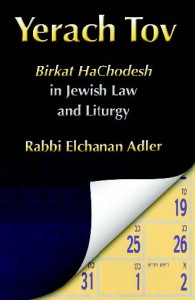Yerach Tov: Birkat HaChodesh in Jewish Law and Liturgy
 Yerach Tov: Birkat HaChodesh in Jewish Law and Liturgy
Yerach Tov: Birkat HaChodesh in Jewish Law and Liturgy
By Rabbi Elchanan Adler
OU Press
Yerach Tov: Birkat HaChodesh in Jewish Law and Liturgy is a gem of a book. Rabbi Elchanan Adler treats the reader to a fascinating, in-depth study of Birkat Hachodesh, the prayer for the new month recited on the Shabbat before Rosh Chodesh. A high point of the Shabbat service, Birkat Hachodesh is often recited with fervor and emotion.
Weaving together material from Talmudic sources, halachic writings from the Middle Ages to our own time, traditional commentaries both ancient and modern, different manuscript versions and scholarly articles, Rabbi Adler examines the historical and halachic background of each component of Birkat Hachodesh. He also explores the themes and meaning of each portion of the prayer, as well as halachic issues that have arisen over the years.
One aspect of the Birkat Hachodesh prayer that receives full treatment is its relationship to the ritual of Kiddush Hachodesh, the procedure followed for declaring Rosh Chodesh when the High Court in Jerusalem functioned. Kiddush Hachodesh was based upon witnesses who viewed the new moon and who testified before the High Court. In the aftermath of the Churban and the cessation of the High Court’s functioning, the determination of Rosh Chodesh, as well as all the festivals, has been based upon the fixed calendar that was developed during Talmudic times. Was one of the original purposes of the Birkat Hachodesh prayer to serve as a modern equivalent to Kiddush Hachodesh? Was it designed to be a remembrance of the Kiddush Hachodesh ritual which we, in our time, are not able to observe? Rabbi Adler delves into the sources and arrives at a nuanced conclusion to these questions.
A highlight of the book is Rabbi Adler’s paragraph-by-paragraph, line-by-line analysis of the text of Birkat Hachodesh. Although comprehensive in scope, the analysis is never dry. For example, in his analysis of the “Yehi Ratzon” paragraph, Rabbi Adler deals with the halachic issue of how we are permitted to include requests for personal welfare and sustenance given the general rule that on Shabbat one is not permitted to pray for one’s personal material benefit. Rabbi Adler also provides a full explanation of the molad, or the moment of the “birth” of the new moon, whose announcement is one of the components of Birkat Hachodesh. Other interesting themes include why the chazzan holds the sefer Torah during the “Mi She’asah Nissim” paragraph, and why Birkat Hachodesh contains a prayer for geulah, the redemption. An annotated bibliography of all of the sources and authors cited in the book provides a wealth of information.
Rabbi Adler is well-equipped to provide us with a book that is both engaging and scholarly. He has served as a rosh yeshivah at the Rabbi Isaac Elchanan Theological Seminary of Yeshiva University since 1998. An accomplished speaker and author, Rabbi Adler has lectured in communities across the country and has published numerous Torah articles in both Hebrew and English on diverse topics of Jewish thought.
Although unfailingly erudite, Rabbi Adler’s treatment of Birkat Hachodesh is written in a direct, appealing manner that is sure to be enjoyed by scholars and lay people alike.
